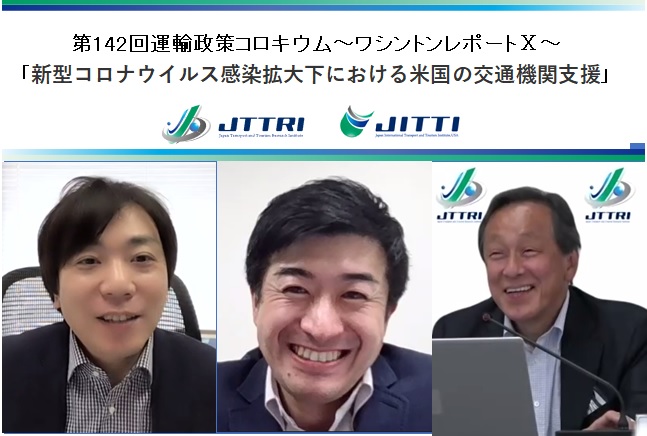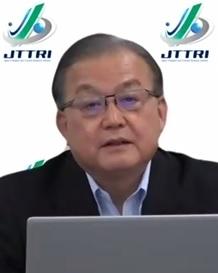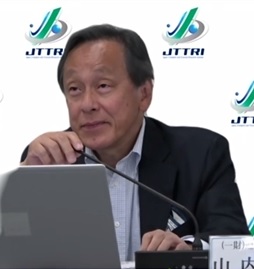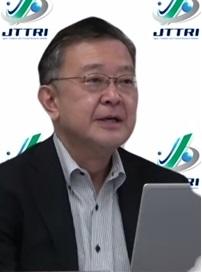Financial Support for the Transportation Sector by the US Federal Government during the Novel Coronavirus Pandemic
- Colloquium
The 142nd Transport Policy Colloquium -Washington Report Ⅹ-(Online)
※Language:Japanese


| Date / Time | Thu, Jun 03,2021 10:00~12:00 |
|---|---|
| Event Number | The 142nd |
| Theme | Financial Support for the Transportation Sector by the US Federal Government during the Novel Coronavirus Pandemic |
| Lecturer | Lecturer:OKIMOTO Shuntaro Senior Research Fellow, Japan International Transport and Tourism Institute, USA (JITTI USA) Commentator:HIBINO Naohiko Professor, National Graduate Institute for Policy Studies(GRIPS) - Q&A session - Coordinator:YAMAUCHI Hirotaka President for Research, Japan Transport and Tourism Research Institute (JTTRI) |
Event Summary
In the United States, COVID-19 has been spreading since last March. Both the number of people infected with and died of the virus in the U.S. are the largest in the world, which means that COVID-19 has been having an extremely large impact on society and the economy and in particular, the impact on transportation industry is enormous.
This report compares the impact of the spread of COVID-19 on US transportation (railways, buses, aviation, etc.) with that on Japanese transportation. The report then reveals how the federal government has used existing and new schemes to support transportation, introducing the difference about the way of thinking about the role of public transportation between the United States and Japan and remarks, analytics, articles etc. in the U.S. on the future outlook of the impact of the spread of COVID-19 on society.
The purpose of the report is to provide a perspective on how to solve the problems which the transportation industry and its stakeholders in Japan are facing, by better understanding of the situation in which U.S. public transportation is facing.
Program of the seminar is as the following
| Opening Remarks |

SHUKURI Masafumi |
|---|---|
| Lecturer |

OKIMOTO Shuntaro |
| Commentator |

HIBINO Naohiko |
| Coordinator |

YAMAUCHI Hirotaka |
| Closing Remarks |

OKUDA Tetsuya |
Outline of the seminar
Mr. Okimoto, a senior researcher at the Washington Institute of International Affairs, gave a presentation titled "Financial Support for the Transportation Sector by the US Federal Government during the Novel Coronavirus Pandemic”. The main points of the presentation are as follows.〇 Status of the spread of novel coronaviruses in the United States
The cumulative number of people infected with the new coronavirus in the U.S. is 33 million, and the death toll is 500,000, which is about 20 times that of Japan.
The impact on rail and bus passengers will be considerable, in comparison with Japan. Bus passengers dropped to 28% (YoY) in April 2020, and rail passengers dropped to 11% (YoY), and have only recently recovered to 50% and 30% respectively.
Logistics was strong in all modes, and support for passenger transportation became a focus of economic measures.
〇 Financial support for U.S. transportation as usual
Formula Grants to transit operators nationwide account for 80% of the Federal Transit Administration's expenditures, while Capital Investment Grants for the construction and extension of new rail and bus rapid transit systems (BRT) account for much of the remainder.
In the U.S., the number of users of public transportation services is low and the costs cannot be covered by operating revenues, including in metropolitan areas. The federal subsidies are the Formula Grants, and they are cooperative subsidies with the states.
The Grants cover capital costs for a wide range of modes, including bus, rail, and paratransit, and are not intended to cover operating costs, with a few exceptions.
〇 Financial support for transportation after the spread of infection
Since the spread of the Coronavirus, the United States has implemented a series of large-scale fiscal stimulus packages.
The CARES Act of March last year was the largest and most far-reaching economic stimulus package in U.S. history at $2.2 trillion, and was characterized by the speed with which it was enacted, taking only about 10 days from the announcement of its formulation.
In the area of transportation, support for airlines was a major item in the overall economic measures. In each of the other modes, measures have been taken on a scale that far exceeds the annual budget.
The $0.9 trillion economic stimulus act passed last December is essentially an extension of the CARES Act measures.
This March's $1.9 trillion economic stimulus bill, which was passed after President Biden's administration took office, reflected the Democratic Party's approach to fiscal policy (big government, protection of the weak) in terms of both the scale and content of the measures, and unlike the previous two acts, it could not be passed on a bipartisan basis.
The transportation-related measures, including their content and scale, have generally been received favorably by the industry.
The support measures for public transportation were based on and expanded upon the Formula Grants system, such as increasing the federal subsidy rate to 100% and allowing the use of the Grants for operating expenses to be expanded. For operators, the Grants functioned as a way to make up for lost fare revenue.
As for support for other modes, flexible measures are being taken without being bound by precedent, such as partial revision of existing systems (public transportation, Amtrak, airports) and creation of new systems (air passenger companies, large buses, etc.).
〇 Lobbying by transportation-related business organizations
The American Public Transportation Association (APTA) was effective in reaching out to legislators through its member mailing list and timely press releases at a time when Congress was considering support measures.
Washington Metropolitan Area Transit Authority (WMATA) has been considering the reduction of subway and bus routes and the elimination of subway stations, and has been trying to stimulate public opinion by announcing the details of its study at a time when Congress was considering additional financial support measures.
Airline for America, an association of major U.S. airlines, has been organizing and visualizing data under the title of "Tracking the Impacts of COVID-19" since immediately after the outbreak of the pandemic. The data is now available on the website. In addition to posting the latest basic business data, it also compares the impact with other industries.
○ Comparison with financial support for transportation in Japan
The Japanese government has made three supplementary budgets since the pandemic, totaling about 73 trillion yen in additional spending, and has only made supplementary budgets of more than 10 trillion yen a few times in the past, with the last fiscal year being the most significant.
The U.S. federal government is pursuing a bold fiscal policy that is about eight times larger than that of Japan.
In Japan, management support (budgetary measures) for transport operators is not as broad as in the U.S., but is targeted at "regional public transportation" where the situation is particularly severe. (ex. measures to prevent the spread of infectious diseases in regional public transportation (second supplementary budget of 13.8 billion yen), revitalization and continuation of regional public transportation (third supplementary budget of 30.5 billion yen), etc.)
○ Summary of the presentation
The U.S. system differs from Japan's in that the U.S. supports capital investment in public transportation from time to time through its budget.
U.S. society is being affected and transformed by the spread of the Coronavirus. The U.S. society has been affected and transformed by the spread of the virus, and the impact of the virus on passenger transportation such as buses and trains is generally greater than in Japan.
In the U.S., fiscal policy has been bolder than in Japan. Unusual measures have been taken to support transit operators, such as subsidizing operating costs and increasing the federal subsidy rate.
In Japan, support should be provided in accordance with the actual situation of the country, based on a timely assessment of the impact of the spread of infection on each mode and the effectiveness of existing support measures.
However, it is true that in the U.S., support is provided based on the requests of industry groups, etc., and Japan should learn from the effective communication between businesses, etc., and the legislature/government.
Afterwards, the commentator, Professor Naohiko Hibino of the National Graduate Institute for Policy Studies (GRIPS), commented on the presentation by Mr. Okimoto.
-A timely topic of interest to many in the midst of the coronavirus pandemic.
-Although there have been various reports on airlines, it is highly commendable that this research is also focusing on public transport within cities, where little information is available.
-An informative and detailed look at the track record of financial support for public transportation in the United States.
-In addition to the track record of support, the history of the support is important for recommendations to Japan.
-There are many differences between the US and Japan to begin with and it is important to take cultural differences into account when interpreting the results.
Regarding the situation in Tokyo, Professor Hibino introduced the research he has been conducting. Using automatic ticket gate data and commuter pass information, he analyzed the changes in commuting behavior of railway passengers during the coronavirus pandemic, as well as the impact of the development of telework on urban rail demand and showed some of the research results as follows.
・For commuter pass passengers, the number of passengers decreased by about 10%, the frequency of use decreased by about 20% (→ shifted to non-regular passengers), and the frequency of use remained almost unchanged by about 70%.
・Many people who used to take the train almost every day have changed their behavior due to the development of telework.
・The development of telework will affect the characteristics of the work site.
・There was almost no change in the boarding time.
・Relocation from the Tokyo metropolitan area to Yokohama, Saitama, etc.
Based on the changes during the coronavirus pandemic, Professor Hibono suggested that the number of rail passengers would decrease due to the development of telework. On the other hand, since there was no change in boarding times, it would be expected that after the coronavirus pandemic, serious congestion problems during peak commuting hours would continue. Therefore, he also suggested that despite the decrease in revenue, measures against congestion would be necessary.
Moreover, based on the results of the research, Prof. Hibino pointed out that with regard to support for railway operators in the Tokyo area, it is more important to provide support for flexible fare setting and congestion countermeasures from a long-term perspective than to provide temporary financial support for the decline in railway passengers due to the effects of government policy against COVID-19. He also pointed out the importance of "developing satellite offices and coworking spaces and linking them with rail use" in order to distribute demand over time and reverse the direction of trips, and the importance of "enhancing related projects along railway lines in order to recover non-regular passengers.
In addition to the above comments, Professor Hibino asked the following questions.
〇Question
① What was the background leading to the support?
Who took the initiative to introduce it?
Let us know the information that only people living in the U.S. can obtain.
② How was the impact of the presidential election on the support?
③ How do you think support measures for public transportation should be taken in Japan?
To these questions, Mr. Okimoto responded as follows.
①The industry lobbied the legislature at various levels from an early stage. One example is the lobbying for measures to support airline operators, not only from the management level and business organizations, but also in parallel from the cabin crew associations and other labor unions. This is thought to have formed a bipartisan support for the support.
②In the election last November, both the president and the congressional majority in both houses of Congress were Democrats, and the two economic stimulus packages since then have had a certain amount of Democratic flavor to them. In terms of domestic economic policy, the Republicans have traditionally been oriented to "small government" and "tax cuts and spending cuts," while the Democrats have been oriented to "big government" and "emphasis on wealth redistribution through higher taxes (on the wealthy people) and bold spending," with public transportation being one symbolic area. Public transportation also contributes to the DPJ's another priority policy of reducing CO2 emissions. On the other hand, regardless of the majority party in Congress or the party in power, there has been a certain amount of continuous support for public transportation.
③First of all, operators of each mode of transportation should begin to check "How severe is the impact of the pandemic on your business? and can it be covered by the economic measures already in place in Japan? In light of the support measures taken in the U.S., there are concerns about the impact on airlines, small- and medium-sized public transport operators, and capital investment in terms of operators' business activities.
At the end of the session, the audience was invited to ask questions, and the following topics were discussed: differences in public transportation business entities in Japan and the U.S., whether there is a tendency to avoid public transportation in the U.S. because of Coronavirus, trends in discussions on behavioral changes in post-Corona, opportunities for discussions between government and industry, and the latest situation of domestic tourism demand, etc.


